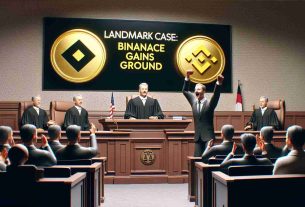Web3 gaming has evolved from a nascent idea to a buzzing industry that has captivated millions of players worldwide, and it lies at the forefront of the cryptocurrency movement. While substantial developments in infrastructure and playability have taken place, there’s more to achieve if web3 gaming aims to tap into the enormous $200 billion traditional video game sector.
The gaming scene is dynamic, inviting a blend of casual mobile games to deeply immersive MMORPGs with escalating production values. GameFi tokens, which enable various in-game transactions, now boast a market cap of $16 billion with more than $1 billion circulating daily. Some tokens, like ALICE, are tied to specific games, while others are woven into the fabric of gaming blockchains, like Chromia (CHR) and Oasys (OAS), providing a foundation for network fees, developer interests, and online purchases.
The sphere has seen substantial investment influx, with $10 billion poured into blockchain gaming between 2022-2023. Now, gaming encapsulates 34% of decentralized app activities, with daily users averaging over 1.1 million—a figure continually on the rise. A portion of this year’s $2.9 billion financial commitment has been funneled into 163 gaming and metaverse endeavors, with traditional game studios also stepping into the web3 realm and improving game quality.
Among the success stories is My Neighbor Alice, where players immerse themselves into a socially interactive world, and Alien Worlds, with its 2.25 million unique wallets created recently, demonstrating robust community support. Other noted genres thriving in the tokenization space are Move-to-Earn, Metaverse, Card-based, Sports, and RPG gaming categories.
However, the journey has seen its share of missteps, with downturns in user engagement and the decline of once-popular titles. Yet, through trial and error, resilient entities like Chromia and Oasys have stood out, backed by innovative technologies to enhance the gaming narrative. For instance, Chromia’s onchain logic has attracted developers with its scalable solutions, while Oasys has focused its efforts on establishing cross-chain functionalities for better gaming asset management.
As the dust settles, it’s becoming evident that certain blockchains – boasting the ideal mix of scale, features, and ecosystem – have solidified their standing in the web3 domain. This determination mirrors the general sentiment that despite the importance of the underlying technology, it’s the user experience and the community that will ultimately dictate the success of web3 gaming ventures.
The Advancements and Landscape of Web3 Gaming
Web3 gaming represents a revolutionary shift in the video game industry, integrating blockchain technology, cryptocurrency, and NFTs to create a decentralized gaming ecosystem. This advancement has allowed for true ownership of in-game assets, potential earnings through play-to-earn models, and a new level of interaction between players and developers.
Key Questions:
– What is Web3 gaming and how does it differ from traditional gaming?
– Who are the major players in the Web3 gaming space?
– What are the potential benefits for players and developers?
– What are the challenges facing Web3 gaming?
– How does blockchain technology impact the gaming experience?
Answers:
– Web3 gaming uses blockchain technology to offer decentralized gaming experiences, often with cryptocurrency and NFTs enabling true ownership of digital assets.
– Major players include gaming platforms like The Sandbox and Decentraland, games like Axie Infinity and Alien Worlds, and blockchain networks specifically designed for gaming such as Chromia and Oasys.
– Benefits for players include earning potential and asset ownership, while developers can benefit from new revenue models and a closer relationship with their audience.
– Challenges encompass scalability, user experience issues, environmental concerns of blockchain networks, and regulatory uncertainty.
– Blockchain technology introduces provable scarcity and authenticity of assets, facilitates peer-to-peer transactions, and can enable new gameplay mechanisms.
Key Challenges and Controversies:
– Scalability: As more users join gaming platforms, the underlying blockchain networks must be able to handle increased transactions without compromising speed and cost.
– User Experience: Web3 games need to match the quality and ease of access that gamers have come to expect from traditional video games.
– Environmental Impact: The energy consumption of proof-of-work blockchains poses environmental concerns, leading some to call for more eco-friendly alternatives.
– Regulatory Issues: With the integration of cryptocurrency and NFTA, web3 games enter the realm of financial regulation, which could affect how they operate globally.
Advantages:
– Ownership of Assets: Players can truly own, trade, and sell their in-game items.
– Play-to-Earn Models: Players can earn cryptocurrency through gameplay, making it possible to earn a living through games.
– Decentralization: A decentralized structure can reduce censorship and allow for more community-driven game development.
Disadvantages:
– Complexity: Understanding blockchain and cryptocurrency can be a barrier for traditional gamers.
– Volatility: The value of in-game assets can fluctuate wildly due to the volatile nature of cryptocurrencies.
– Security Risks: Smart contract vulnerabilities and the irreversible nature of blockchain transactions raise concerns over potential fraud and hacking.
In conclusion, the future of Web3 gaming promises a blending of immersive gameplay with innovative blockchain technology. While challenges like user experience and environmental impact need to be addressed, the potential benefits for players and developers alike could very well redefine the gaming industry.
For further information about Web3, you may visit the following main domains:
– Ethereum
– Binance Smart Chain
– Polkadot
– Solana
– Flow by Dapper Labs
These links lead to the main pages of various blockchain platforms that support Web3 development and are known for their involvement in the gaming sector.



